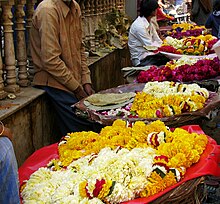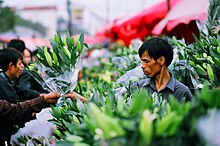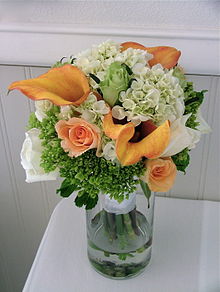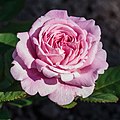Cut flowers


Cut flowers are flowers or flower buds (often with some stem and leaf) that have been cut from the plant bearing it. It is usually removed from the plant for decorative use. Typical uses are in vase displays, wreaths and garlands. Many gardeners harvest their own cut flowers from domestic gardens, but there is a significant floral industry for cut flowers in most countries. The plants cropped vary by climate, culture and the level of wealth locally. Often the plants are raised specifically for the purpose, in field or glasshouse growing conditions. Cut flowers can also be harvested from the wild.
The cultivation and trade of flowers is a specialization in horticulture, specifically floriculture.
Cultivation[]
Cut flower cultivation is intensive, usually on the basis of greenhouse monocultures, and requires large amounts of highly toxic pesticides, residues of which can often still be found in flower shops on imported flowers. [1][2][3]
These facts have spurred the development of movements like "Slow Flowers", which propagates sustainable floriculture in the consumer country (U.S., Canada) itself.[4]
Uses[]
A common use is for floristry, usually for decoration inside a house or building. Typically the cut flowers are placed in a vase. A number of similar types of decorations are used, especially in larger buildings and at events such as weddings. These are often decorated with additional foliage. In some cultures, a major use of cut flowers is for worship; this can be seen especially in south and southeast Asia.
Sometimes the flowers are picked rather than cut, without any significant leaf or stem. Such flowers may be used for wearing in hair, or in a button-hole. Masses of flowers may be used for sprinkling, in a similar way to confetti.
Garlands, wreaths and bouquets are major derived and value added products.
Popular genera[]
Among the most popular species and genera in the worldwide cut flower trade are the following:[5][6][7][8]
- Alstroemeria
- Aster
- Banksias
- Begonias
- Bellflower Campanula
- Bird of Paradise (Strelitzia reginae)
- Bulb flowers, mostly available in spring
- Busy lizzies
- Carnations (Dianthus caryophyllus)
- Chinese lantern (Physalis alkekengi)
- Chrysanthemum
- Clematis
- Cyclamen
- Daisies
- Delphiniums
- Epacris impressa
- Fuchsia
- Gardenia
- Geraniums
- Gerberas
- Gladioli
- Gladiolus
- Gumamela
- Gypsophila
- Heather (Calluna vulgaris)
- Hydrangeas
- Iris
- Lavender (Lavendula)
- Leucadendron
- Lilac
- Lilies (Lilium)
- Stargazer Lily
- Lobelias
- Love Lies Bleeding (Amaranthus caudatus)
- Love-in-a-Mist (Nigella)
- Oleander
- Orchids
- Cooktown Orchid
- Pansy
- Pelargoniums
- Petunias
- Plumeria
- Poinsettia
- Primrose (Primulaceae)
- Protea
- Red and Green Kangaroo Paw
- Roses (Rosa)
- Royal Bluebell
- Sampaguita
- Snapdragon
- Sturt's Desert Rose
- Sunflowers (Helianthus annuus)
- Tasmanian Blue Gum
- Verbenas
- Waratah
- White trillium
- Ylang Ylang
Not mentioned are differing wildflowers, depending on season and country.
Longevity[]

Once flowers are removed from the plant they continue to grow slowly, but have a diminished capability of receiving the nutrients that are vital for their survival. In most countries, cut flowers are a local crop because of their perishable nature. In India, much of the product has a shelf life of only a day. Among these are marigold flowers for garlands and temples, which are typically harvested before dawn, and discarded after use the same day.
The majority of cut flowers can be expected to last several days with proper care. This generally requires standing them in water in shade. They can be treated in various ways to increase their life. According to James C. Schmidt, a horticulturist at the University of Illinois, originally putting cut flowers in a sterilized vase is important to extending the life of the flowers. Vases can be cleaned using a household dish detergent or a combination of water and bleach. Using these disinfectants ensures that there will be less bacteria growing within the vase that could potentially cause the plant to wilt and die at a faster rate. Schmidt also claims that cutting the flowers diagonally with a sharp knife under running water ensures that they can immediately take up fresh and clean water. Re-cutting the stems periodically will ensure that there is a fresh surface from which the stems can take up water. This will allow the flowers to last even longer. Other ways to care for vase flowers includes keeping flowers away from ceiling fans and air-conditioning vents as this can lead to dehydration, keeping flowers away from fresh fruit of vegetables, using filtered water rather than tap water so as to avoid both chlorine and fluoride, and keeping flowers away from your television.
There is also a market for 'everlasting' or dried flowers, which include species such as Xerochrysum bracteatum. These can have a very long shelf life.
Additives[]
According to the Brooklyn Botanical Garden, different additives can be used to prolong the lives of fresh cut flowers. Experiments were performed with various substances mixed with water, including aspirin, vitamin pills, vinegar, pennies, and flower food to test their effect on cut flowers' lifespans.[9] Each plant was placed in the same environment and the same type of plant was used in each vase.
This research found that the best additive for flowers was the retailer-provided "flower food" that is usually given with a bouquet. Plants are known to thrive in an environment where there are few bacteria, plenty of food for energy, and water uptake is encouraged. Flower foods contain an acidifier that helps to adjust the water's pH. With a lower pH the water and food conducting system within the flower can work at maximum efficiency. The sugar in the food will be used by the plant as an energy source, which had been lost when the flower was cut away from its root. With these nutrients the plant will be able to fully develop. Finally, there are stem unpluggers that will make sure that the flower can easily take up water and nutrients that can later be used to take care of the needs of the rest of the plant.[10] This combination gives the fresh cut flowers everything that they need to survive longer. When tests were carried out in St. Mary's College C.S.S.p, Rathmines, Dublin, however, results showed that glucose was more effective at prolonging the life of cut flowers than the commercial plant food. The experiment was carried out as part of the Junior Certificate Science Examination set by the Irish State Examinations Commission 2008.
Trade[]
The largest producers are, in order of cultivated area, China, India, and the United States. The largest importer and exporter by value is the Netherlands, which is both a grower and a redistributor of crops imported from other countries. Most of its exports go to its European neighbours.[11][12]
In recent decades, with the increasing use of air freight, it has become economic for high value crops to be grown far from their point of sale; the market is usually in industrialised countries. Typical of these is the production of roses in Ecuador and Colombia, mainly for the US market, and production in Kenya and Uganda for the European market. Some countries specialise in especially high value products, such as orchids from Singapore and Thailand.
As with the production of fruit and vegetables, the industry depends on significant amounts of water, which may be collected and stored by the farm owners. The Patel Dam failure in May 2018, associated with a large Kenyan rose farm, killed dozens of people.
The total market value in most countries is considerable. It has been estimated at approximately GBP 2 billion in the United Kingdom, of the same order as that of music sales.[13]
Further reading[]
- Arbeláez, María Angélica , Marcela Meléndez, and Nicolás León "The Emergence of Fresh Cut-Flower Exports in Colombia" In Export Pioneers in Latin America Edited by Charles Sabel et al., Baltimore: Inter-American Development Bank 2012. ISBN 9781597821414
- Austin, James E. 1990. Cut Flower Industry in Colombia (Abridged). Boston: Harvard Business School.
- Encinales, Felipe, and James E. Austin. 1990. "The Cut Flower Industry in Colombia". In James E. Austin with Tomás O. Kohn, Strategic Management in Developing Countries: Case Studies. New York: The Free Press 1990.
- Goody, Jack. The culture of flowers. Cambridge University Press,
- "Global Leaders In Cut Flower Exports". worldatlas.com. 2017.
Though its dominance has somewhat waned over the past decade, the Netherlands still dominates this market sector.
See also[]
- Floral industry
- Slow Flowers
- Ornamental plant
- Flower arrangement
- History of flower arrangement
- Dutch flower bucket
References[]
- ^ Toumi, Khaoula; Vleminckx, Christiane; van Loco, Joris; Schiffers, Bruno (2016-09-23). "Pesticide Residues on Three Cut Flower Species and Potential Exposure of Florists in Belgium". International Journal of Environmental Research and Public Health. MDPI AG. 13 (10): 943. doi:10.3390/ijerph13100943. ISSN 1660-4601. PMC 5086682. PMID 27669276.
cut flowers are ... among the intensive crops grown in greenhouses in Great Britain. As in any intensive culture, flowers require the use of a wide range of pesticides to control diseases and pests, which can damage production and marketability. Plants and flowers entering into the European market must meet stringent regulations on plant health designed to prevent introduction of some pests or diseases. Therefore, imported cut flowers receive heavy pesticide applications prior to shipment.
- ^ "Pesticides and Cut Flowers". National Wildlife Federation. 2000-06-01. Retrieved 2019-02-13.
Growers of flowers, the most delicate of agricultural crops, are traditionally heavy users of farm chemicals, including some that are highly toxic or suspected to cause cancer. I
- ^ Goodman, Joshua (2007-02-12). "Valentine roses get dipped in chemicals - World news - World environment". msnbc.com. Retrieved 2019-02-13.
Most of the toxic assault takes place in the waterlogged savannah surrounding the capital of Colombia, which has the world's second-largest cut-flower industry after the Netherlands, producing 62 percent of all flowers sold in the United States. ... 36 percent of the toxic chemicals applied by farms in 2005 were listed as "extremely" or "highly" toxic by the World Health Organization, Isaza acknowledged.
- ^ https://slowflowers.com/about-us.html
- ^ http://blog.floralife.com/2015/02/06/most-popular-cut-flowers/
- ^ https://www.gardenguides.com/91299-top-10-cut-flowers.html
- ^ https://www.theflowerexpert.com/content/flowerbusiness/floralindustry/newflowergrowingcentres/top-ten-flowers
- ^ https://www.thespruce.com/best-cut-flower-varieties-4152956
- ^ "Additives for cut flowers".
- ^ Additives for cut flowers
- ^ "Sectoral Activities Department (SECTOR)". Ilo.org. Retrieved 2011-12-05.
- ^ "Archived copy" (PDF). Archived from the original (PDF) on 2012-06-30. Retrieved 2011-12-05.CS1 maint: archived copy as title (link)
- ^ Gardening (2007-07-13). "Country roses: A cut above". London: Telegraph. Retrieved 2011-12-05.
External links[]
- Cut-Flower Care — How to Make Your Fresh-Cut Flowers Last by Rose G. Edinger, Brooklyn Botanical Garden, Spring 2003, retrieved October 21, 2006
- — What are preserved flowers? Everything you want to know about preserved flowers by Floralonly, Albert, published 28, May 2020
- Floriculture
- Floristry
- Floral industry

